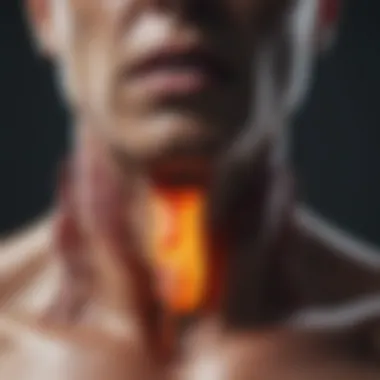Impact of Radiation on Thyroid Health and Function


Intro
When we chat about health, especially regarding the thyroid, it’s important to remember that even small environmental factors can have weighty consequences. In recent years, the relationship between radiation exposure and thyroid health has garnered significant attention. From nuclear accidents to medical imaging, the effects of radiation on this delicate gland can vary widely, and understanding this relationship is critical. As we delve into this matter, it’s essential to reflect on how exposure to different forms of radiation can disrupt the normal functioning of the thyroid and lead to various disorders.
Research Background
Overview of the Scientific Problem Addressed
The thyroid gland plays a pivotal role in regulating metabolism, growth, and development in the human body. However, its intimate relationship with radiation is a relatively complex issue. Research indicates that the thyroid is particularly susceptible to radiation damage, which may lead to conditions ranging from hypothyroidism to thyroid cancer.
Historical Context and Previous Studies
Historically, certain events have highlighted the impact of radiation on thyroid health. The atomic bombings in Hiroshima and Nagasaki and the Chernobyl disaster in 1986 were wake-up calls for the scientific community. After the Chernobyl incident, several studies emerged that elucidated the link between the release of radioactive isotopes, particularly iodine-131, and increased rates of thyroid disorders, especially in children and young adults.
Notable studies from the International Agency for Research on Cancer and other institutions delved into epidemiological data, revealing a troubling trend: the higher the exposure to radiation, the greater the risk of thyroid-related complications. These findings have led to a deeper investigation into the mechanisms through which radiation affects thyroid tissue.
Findings and Discussion
Key Results of the Research
Recent research has brought to light several key findings regarding the impact of various radiation types—such as ionizing radiation and non-ionizing radiation—on thyroid health. For instance, ionizing radiation has been shown to cause cellular damage and interfere with the gland’s hormonal production.
"Radiation exposure, especially during early childhood, is proven to significantly increase the risk of developing thyroid cancer in later life."
Interpretation of the Findings
The interpretation of these findings raises essential questions about public health policies and preventive measures regarding radiation exposure. Particularly in areas previously impacted by nuclear incidents, monitoring thyroid health emerges as a priority. The data point to a pressing need for proactive measures, including screening and potential interventions in populations at risk, especially considering the long latency periods associated with radiation-induced thyroid ailments.
In summary, the research into the effects of radiation on the thyroid underscores a critical area of health that demands ongoing attention and study. Understanding the multifaceted implications of radiation exposure is paramount for healthcare providers, individuals in the medical community, and researchers.
Prelude to Radiation and Thyroid Function
Understanding how radiation impacts thyroid function is crucial for grasping its broader implications on health. The thyroid gland, a butterfly-shaped organ located at the base of the neck, plays a pivotal role in regulating metabolism, growth, and overall endocrine functions. Given the intricacies of its function, any disruption, particularly from external factors like radiation, can lead to significant health issues.
Radiation exposure, particularly from environmental or medical sources, has long been a topic of research and concern. It’s essential to comprehend not just the mechanisms through which radiation affects thyroid tissue, but also the potential long-term outcomes. This knowledge is vital for informing treatment protocols, setting safety standards, and guiding public health initiatives.
Importance in Clinical and Public Health Context
- Clinical Relevance: An in-depth exploration of radiation's effects on the thyroid can lead to improved diagnostics and treatment strategies for thyroid disorders. Health practitioners must understand these dynamics to better assess risks and manage patient care.
- Risk Awareness: Increased awareness about radiation exposure can empower individuals to minimize risks, especially in at-risk populations or regions vulnerable to fallout from nuclear events.
- Future Research Directions: A nuanced grasp of this subject opens avenues for innovative research aimed at mitigating radiation's adverse effects, benefitting both individuals and communities.
Through this article, we aim to dissect these crucial elements, offering readers a clearer picture of the intersection between radiation and thyroid health. By doing so, we hope to provide insights that can guide future studies and influence health policy, creating a ripple effect that promotes better health outcomes.
Overview of Thyroid Anatomy and Physiology
The thyroid gland plays a vital role, functioning like the body's metabolic conductor. It primarily produces hormones such as thyroxine (T4) and triiodothyronine (T3), essential for energy regulation and metabolic processes.
The anatomy of the thyroid includes:
- Follicles: These are the functional units of the thyroid where hormone production occurs. Each follicle is lined with follicular cells responsible for synthesizing T3 and T4.
- Parafollicular Cells: Also known as C cells, they produce calcitonin, a hormone involved in calcium homeostasis.
- Blood Supply: The gland has a rich vascular network that facilitates the delivery of hormones into the bloodstream.
Types of Radiation: Ionizing vs. Non-Ionizing
Radiation comes in various forms, but it is typically categorized as ionizing or non-ionizing, each with distinct characteristics and implications for health.
- Ionizing Radiation: This type of radiation has enough energy to remove tightly bound electrons from atoms, leading to the formation of charged particles or ions. Common sources include x-rays, gamma rays, and particles emitted from radioactive substances. Ionizing radiation is well-known for its potential to cause damage to cellular DNA, which can hinder thyroid function and potentially lead to malignancies.
- Non-Ionizing Radiation: Unlike its ionizing counterpart, non-ionizing radiation carries less energy and includes electromagnetic fields from devices like microwaves, radio waves, and visible light. Though generally considered less harmful, ongoing studies still explore any possible long-term effects on endocrine health.
Mechanisms of Radiation Interaction with Thyroid Tissue
Understanding how radiation interacts with thyroid tissue is paramount in grasping the overall effects it can have on thyroid health. The thyroid gland, a small butterfly-shaped entity located in the neck, plays a pivotal role in regulating metabolism, growth, and development through hormone production. These hormones, such as thyroxine (T4) and triiodothyronine (T3), are essential for numerous physiological functions. However, when exposed to radiation, the mechanisms by which thyroid cells respond can lead to significant clinical implications. This section delves into the cellular responses, impacts on hormone synthesis, and the potential for genetic damage—all critical factors to appreciate when evaluating radiation exposure's effects.
Cellular Response to Radiation Exposure
When thyroid tissue comes in contact with radiation, whether it's from environmental factors, medical treatments, or accidents, it undergoes a complex cellular response. At a basic level, the cells may exhibit three main reactions: repair, apoptosis, or neoplastic changes.


- Repair Mechanisms: Upon exposure, thyroid cells often initiate repair processes. Enzymatic pathways work overtime to mend any DNA damage, but this isn’t always effective. Factors such as dose, duration, and the type of radiation can influence the efficacy of these repair mechanisms.
- Cell Death—Apoptosis:
In scenarios where the damage is too extensive, thyroid cells can trigger programmed cell death, or apoptosis. This serves as a defensive measure to prevent the proliferation of cells with irreparable damage, thus reducing the risk of malignancy. - Neoplastic Changes:
Unfortunately, if cells survive the initial damage and repair mechanisms fail, there’s a risk of mutations leading to uncontrolled cell growth—this could eventually transition into thyroid cancer. The intricate balance of these responses is crucial for maintaining thyroid health.
Impact of Radiation on Thyroid Hormone Synthesis
The ability of the thyroid gland to produce hormones is significantly affected by radiation exposure. Ionizing radiation can impact several pivotal processes involved in hormone synthesis.
- Thyroid Follicular Cell Activity:
Radiation can disrupt the normal function of follicular cells, which are responsible for producing T4 and T3. Disruption in iodine uptake can lead to reduced hormone synthesis, potentially culminating in hypothyroidism. - Hormone Secretion:
Even if hormone synthesis occurs, radiation-induced changes in cellular signaling pathways can impair the secretion of these hormones into the bloodstream, leading to an inadequate supply in bodily functions.
This interruption can have broader implications on metabolism, heart rate, and even cognitive functions, as hormones govern much of what our bodies do.
Radiation-Induced Genetic Damage in Thyroid Cells
The genetic material within thyroid cells can also be affected by radiation, leading to mutations. These mutations stem from the DNA damage caused by high-energy particles or waves. The repercussions can be far-reaching:
- Mutation Accumulation:
Even with repair mechanisms, some mutations may escape correction. Accumulation of harmful mutations can compromise the integrity of thyroid cell functions. - Potential for Cancer Development:
Over time, specific mutations can give rise to oncogenes or disable tumor suppressor genes, setting the stage for thyroid carcinomas. The correlation between such genetic changes and thyroid cancer is well documented in populated areas affected by significant radiation exposure, such as survivors from the Chernobyl disaster.
"Recurrent exposure to radiation enhances the risk of cellular damage that can eventually lead to malignancy in the thyroid gland."
The understanding of these mechanisms underscores the importance of careful monitoring of individuals exposed to radiation, especially in contexts like medical treatments or accidents.
Clinical Effects of Radiation on the Thyroid
The interplay between radiation exposure and thyroid health is not just a fleeting topic of conversation; it's a matter of significant concern that bears serious implications for public health. This section delves into various clinical effects, examining how radiation impacts thyroid function and what that might mean for those at risk or affected by such exposures. Understanding these effects is vital, as they can influence treatment decisions, health policies, and preventative measures in healthcare systems.
Hypothyroidism and Radiation Exposure
When the thyroid is beholden to radiation, one of the most common clinical outcomes is hypothyroidism. This condition arises when the thyroid fails to produce adequate amounts of hormones necessary for metabolic function. Following radiation exposure, particularly from sources such as nuclear accidents or radiation therapy, the thyroid tissues may undergo damage. As the cells are bombarded, their ability to synthesize hormones can diminish, ultimately manifesting as fatigue, weight gain, and sensitivity to cold.
"In a nutshell, hypothyroidism can lead to a cascade of health issues; what starts as mild fatigue can spiral into significant organ dysfunction if left unchecked."
Thyroid Nodules: Risk Assessment Post-Radiation
Thyroid nodules are another clinical consideration post-radiation exposure. These lumps, which can be benign or malignant, often arise as a reaction to cellular injury. Research indicates that individuals exposed to radiation might experience a higher prevalence of nodules compared to unexposed populations. Assessing the risk of these nodules, especially their potential to become cancerous, is paramount. Standard procedures include ultrasound evaluations and, in certain cases, biopsies to ascertain the nature of these nodules.
- Key factors affecting risk assessment:
- Type of radiation: Higher risks are often associated with ionizing radiation as opposed to non-ionizing.
- Dose of radiation: Increased doses correlate better with the likelihood of developing nodules.
- Timing of exposure: The earlier the exposure in life, the greater the risk.
Thyroid Cancer: Incidence and Radiogenic Factors
Thyroid cancer presents as a grave consequence of radiation exposure. Post-1970s nuclear events, rates of this cancer type notably surged in regions exposed to significant radiation. The relationship is straightforward: certain types of radiation can damage the genetic material in thyroid cells, setting the stage for malignant transformations.
Types of Thyroid Cancer Associated with Radiation
Several thyroid cancer types have been closely linked with radiation exposure. Among these, papillary thyroid carcinoma has garnered attention, noted for its frequent occurrence in survivors of nuclear fallout, such as those affected by the Chernobyl disaster. The distinctive aspect of this type of cancer lies in its generally good prognosis, yet the risk of recurrence persists. Understanding these types, along with the mechanisms behind their development, is critical for appropriate clinical management.
- Characteristics of papillary thyroid carcinoma:
- Common among younger patients: Frequently observed in individuals exposed to radiation during childhood.
- Less aggressive behavior: Often managed effectively with surgery, showing favorable survival rates.
Latency Periods and Risk Factors
Latency periods refer to the time gap between radiation exposure and the onset of thyroid cancer. Recognizing these periods is crucial for identifying at-risk populations and implementing efficient monitoring.
- Key characteristics of latency periods:
- Duration Varies: Depending on the individual and the type of exposure, latency can range from a few years to several decades.
- Influencing factors: Age at exposure, sex, and the total radiation dose significantly impact risk.
The distinctive feature of understanding latency lies in tailoring screening programs accordingly. For instance, young individuals exposed in childhood might require ongoing monitoring well into adulthood, paving the way for timely interventions if malignancy arises.
In summary, comprehending the clinical effects of radiation on thyroid health allows for more informed discussions surrounding risk management, treatment strategies, and preventative healthcare policies.
Epidemiological Studies on Radiation and Thyroid Disorders


Exploring the intersection of radiation exposure and thyroid health is paramount in understanding long-term health implications. Epidemiological studies provide a window into the real-world effects of radiation on diverse populations, paving the way for actionable insights and public health strategies. These studies often draw correlations that deepen our comprehension of how differing levels and types of radiation—be it from medical treatment or environmental disasters—impact the thyroid gland over time.
Linking clinical findings with public health data allows for a more robust assessment of health risks involved, particularly in assessing vulnerable communities. Such investigations play a key role in forming guidelines and recommendations for preventive measures and screening protocols. For instance, by evaluating the rates of thyroid disorders post-radiation exposure, researchers can pinpoint which demographics require heightened vigilance, thus enriching our overall understanding.
Case Studies: Chernobyl and Fukushima
The Chernobyl disaster in 1986 and the Fukushima Daiichi nuclear disaster in 2011 are two landmark events that have significantly contributed to the body of knowledge surrounding radiation's impacts on thyroid health.
- Chernobyl: This catastrophic event exposed thousands to radioactive iodine, leading to a spike in incidences of thyroid cancer, particularly in children. Studies have shown that thyroid cancer rates in those exposed have increased dramatically over the years, a stark representation of radiogenic effects.
- Fukushima: While Fukushima’s immediate impact was on a smaller scale, ongoing research has been crucial in assessing long-term effects. Notably, it shed light on the psychological stress related to radiation exposure, which itself can influence health outcomes, thereby complicating any physical health assessments.
These case studies illustrate not only the biological risks but also the psychological and social dimensions, providing a more rounded perspective of radiation’s aftermath.
Longitudinal Studies and Data Analysis
Longitudinal studies lend themselves well to tracking the health of populations over time, facilitating the identification of trends and potential causal relationships between radiation exposure and thyroid dysfunction. Such studies highlight various factors like age or gender, which can markedly influence vulnerability to radiation.
Effect on Different Age Groups
When considering the age aspect, younger individuals tend to show a higher susceptibility to radiation-induced thyroid conditions. For example, children exposed during the Chernobyl incident exhibited higher rates of thyroid cancer compared to adults. This difference emphasizes the need for targeted public health strategies that consider age-specific vulnerabilities.
- Key Characteristic: The inherent biological differences in thyroid growth and development between children and adults play a significant role in this heightened risk.
- Benefit: Focusing on age disparities can enhance screening and preventive strategies specific to age groups at risk.
- Unique Feature: Different age groups exhibit disparate responses to radiation, necessitating adaptable frameworks in research and healthcare provisioning.
Sex-Based Differences in Susceptibility
Diving into sex-based differences, it has been observed that females tend to experience higher rates of thyroid disorders following radiation exposure. This can be attributed to hormonal factors and the inherent biological differences that influence thyroid physiology.
- Key Characteristic: Established trends show that women diagnosed with thyroid cancer post-radiation constitute a significant percentage compared to their male counterparts.
- Benefit: Identifying these differences helps to craft more precise public health policies that target at-risk groups effectively.
- Unique Feature: Understanding how sex impacts susceptibility aids in refining risk-assessment models that can be crucial in follow-up studies and preventive practices.
In summary, epidemiological studies shine a light on the vast landscape of radiation’s effects on thyroid health, guiding us to strategic health interventions while elucidating the complexities surrounding individual risk factors.
Preventive Strategies and Public Health Implications
In any discussion about public health, especially when it involves potential hazards like radiation, it's crucial to emphasize a proactive approach. Preventive strategies not only shield individuals from risks but also reduce the strain on healthcare systems. Understanding how to mitigate the effects of radiation exposure can save countless lives and enhance the well-being of communities at risk of thyroid disorders.
Preventive strategies encompass a myriad of elements, from advancing public education on radiation risks to implementing regulatory measures that ensure safety. Personal and community-level awareness about radiation can lead to informed choices, thereby fostering an environment where risks are minimized.
Public Health Recommendations for Radiation Exposure
The primary recommendation for public health in relation to radiation exposure is the principle of keeping doses low, as low as reasonably achievable (ALARA). This principle is grounded not only in individual safety but also in community health priorities, ensuring that the public remains aware and engaged in discussions about radiation.
Some effective recommendations include:
- Regular Screening: Encouraging regular health screenings and thyroid tests for individuals in high-risk areas can lead to early detection of potential complications, easing treatment timelines.
- Community Education Campaigns: Public health authorities should invest in campaigns that educate vulnerable populations about the dangers of radiation, particularly regarding occupational exposure and environmental factors.
- Monitoring Environments: Establishing a monitoring system for radiation levels in urban areas can help keep communities informed and protected, allowing timely actions if radiation levels exceed safe limits.
- Emergency Preparedness Plans: It’s essential for communities to have robust emergency preparedness strategies in place, addressing scenarios involving radioactive exposure, such as nuclear accidents. This includes clear evacuation routes and public warning systems.
In each of these areas, collaboration between health professionals, governmental bodies, and local communities is vital.
Role of Iodine in Radiation Protection
One of the most recognized methods for protecting the thyroid from radiation exposure is iodine prophylaxis. Iodine is critical for healthy thyroid function, as it is a necessary component in the synthesis of thyroid hormones. However, when the body is exposed to radiation, particularly isotopes of iodine, the thyroid gland can absorb this radioactive material, significantly increasing the risk for thyroid cancer.
Leveraging iodine as a protective measure involves the following strategies:
- Potassium Iodide (KI) Distribution: In the event of a radiation emergency, the distribution of potassium iodide tablets may be recommended. These tablets saturate the thyroid gland, reducing its capacity to absorb harmful radioactive isotopes.
- Public Awareness on Food Sources: Education regarding iodine-rich foods can enhance population-wide intake, providing a natural buffer against radiation. Foods like iodized salt, dairy products, and seafood are notable sources.
- Government Guidelines: Public health officials should develop clear guidelines on iodine supplementation, especially for populations residing in high-risk vicinities.
In short, strategies involving iodine use can effectively combat the adverse effects of radiation on thyroid health. By prioritizing both public education and the strategic distribution of iodine, communities can significantly enhance their resiliency against radiation exposure.
"Prevention is better than cure" - and in the realm of radiation exposure, this saying takes on an even more profound meaning when considering the long-term implications for thyroid health.
Thyroid Screening and Management in At-Risk Populations
Thyroid screening and management is crucial for individuals exposed to radiation, especially those living in areas where such exposure might be more prevalent. In the aftermath of nuclear accidents or in regions with elevated radiation levels, it becomes essential to understand the health implications regarding the thyroid gland. The thyroid, which plays an integral role in metabolism and overall health, can be adversely affected by even low levels of radiation. Thus, proactive monitoring and intervention strategies are necessary for those deemed at risk.
Screening for thyroid disorders often involves measuring levels of thyroid hormones, particularly TSH (Thyroid-Stimulating Hormone) and T4. Regular assessments can identify abnormalities early before they lead to significant health complications. Furthermore, understanding one’s iodine intake is also vital. Iodine is a crucial element for thyroid hormone production, and its status can influence the thyroid's resilience against radiation-induced damage.


Guidelines for Clinical Monitoring
When developing guidelines for clinical monitoring, several key aspects should be considered:
- Frequency of Screening: Individuals at risk should undergo thyroid function tests annually or more frequently if exposure levels are particularly high.
- Technology Utilization: Employing ultrasound imaging can help detect structural changes in the thyroid, such as nodules or alterations in size that may point to malignancy.
- Risk Stratification: Identifying who is truly at risk is important. Age, sex, and previous exposure history should inform decisions on monitoring frequency and methods.
By combining these strategies, healthcare providers can form a comprehensive monitoring plan tailored to individual needs, thus improving outcomes.
Intervention Strategies for Affected Individuals
In cases where thyroid dysfunction is identified post-exposure, targeted intervention strategies must be instated. This approach includes medical interventions, lifestyle adjustments, and ongoing follow-up to ensure comprehensive care.
Hormone Replacement Therapy
Hormone replacement therapy is commonly employed when individuals develop hypothyroidism, which may be caused or exacerbated by radiation exposure. The principal aspect of this therapy is restoring normal hormone levels, which can be pivotal in preventing complications associated with thyroid hormone deficiency. This therapy is particularly beneficial due to its straightforward administration and efficacy.
The key characteristic of hormone replacement is its adaptability to each individual's needs, allowing for personalized treatment plans. Patients typically use levothyroxine, a synthetic form of the T4 hormone.
The unique feature of this therapy is its ability to restore normal metabolic function relatively quickly, often improving the quality of life markedly for those affected. However, while generally effective, there can be disadvantages, such as the need for lifelong monitoring of hormone levels, as well as possible side effects associated with over-replacement.
Surgical Options for Thyroid Carcinoma
For patients diagnosed with thyroid carcinoma, especially following radiation exposure, surgical options become a focal point. One significant aspect of surgical intervention is total thyroidectomy, which involves the complete removal of the thyroid gland. This approach can be a beneficial and often necessary step in managing thyroid cancer, particularly when the malignancy poses a risk of metastasis.
The standout characteristic of these surgical options is their potential to eradicate cancerous tissues completely, thus improving long-term survival rates. Moreover, the advent of minimally invasive techniques has made these surgeries less daunting for patients.
Nevertheless, surgical intervention comes with its own set of challenges. Patients may experience complications post-surgery, including changes in voice or calcium metabolism due to damage to nearby structures. Additionally, those who undergo thyroidectomy will require lifelong hormone replacement therapy, underscoring the need for comprehensive patient education about the implications of such a procedure.
Overall, early thyroid screening and prompt management for at-risk populations not only enhance individual health outcomes but also serve as vital preventive measures against the long-term effects of radiation on thyroid function.
Research Directions and Future Perspectives
In the broader narrative of thyroid health, the exploration of research directions and future perspectives holds significant weight. The necessity to understand the effects of radiation on thyroid function is amplified by the ongoing developments in medical science, health policies, and environmental factors. By delving deep into this topic, researchers and healthcare providers can come to grips with the multifaceted relationships between radiation exposure and the resulting thyroid disorders, offering a more holistic view of the intricacies involved.
Emerging Technologies in Radiation Research
The advancements in radiation research are paving new paths for understanding the thyroid's vulnerability to radiation. Technologies like advanced imaging techniques, such as PET scans and MRI, now allow for non-invasive assessment of thyroid tissue. In addition, the use of ionizing radiation detection devices contributes to more accurate measurements of exposure levels. This high-tech toolkit enables a more refined analysis of how radiation interacts with thyroid cells.
- Genomic Sequencing: With innovations in genomic editing technologies like CRISPR, researchers can manipulate specific genes to observe their effects on radiation response. This can ultimately unveil whether certain genetic predispositions increase thyroid sensitivity to radiation.
- Artificial Intelligence: Utilizing AI algorithms can help identify patterns in large datasets, correlating radiation exposure with incidences of thyroid disorders. This can lead to more effective risk assessment tools for healthcare providers and patients alike.
The contribution of these technologies is pivotal, not only in refining our understanding of mechanical interactions but also in guiding clinical practices tailored to individual needs. As these emerging technologies continue to evolve, their integration into routines will assist significantly in managing patient outcomes.
Gaps in Current Knowledge and Need for Further Study
There is a host of gaps in the current knowledge surrounding the effects of radiation on thyroid health that warrant further investigation. For instance, the long-term effects of low-dose radiation exposure are still not fully understood. While research often emphasizes high-dose exposures—like those seen in nuclear accidents—much remains nebulous about what even minimal exposures might entail.
The specificity of radiation types is another area ripe for exploration. Non-ionizing radiation, such as that from mobile phones, features prominently in discussions of health risks, but conclusive evidence tying it definitively to thyroid disorders remains elusive.
- Diversity of Populations: There is a pressing need to explore how age, sex, and genetic background influence individual responses to radiation. Children, pregnant women, and the elderly may exhibit varying vulnerability, yet this is not sufficiently detailed in current studies.
- Environmental Factors: Additional research into how other environmental factors interact with radiation exposure is crucial. Pollution, nutritional deficiencies, and lifestyle choices might significantly affect the thyroid's resilience or vulnerability to radiation, raising further questions about prevention and treatment strategies.
"Understanding and addressing these gaps not only enhances scientific dialogue but also brings to light crucial implications for public health policy."
End
The conclusion of this article holds significant weight, offering a crucial recap of the intricate relationship between radiation exposure and thyroid health. It is paramount to understand that the thyroid gland, though petite in size, plays a colossal role in regulating metabolism and overall bodily functions. Given this, any disruption caused by radiation can have far-reaching consequences.
Summary of Key Findings
In summary, our exploration has uncovered several pivotal points:
- Mechanisms of Damage: Radiation interacts with thyroid tissues at a cellular level, leading to adverse effects that can result in conditions such as hypothyroidism and thyroid cancer.
- Types of Radiation: Both ionizing and non-ionizing radiation have the potential to impact the thyroid differently, with ionizing radiation being notably harmful.
- Epidemiological Evidence: Studies of incidents like Chernobyl and Fukushima highlight real-world examples of how radiation exposure correlates with increased thyroid disorders, particularly in vulnerable populations.
- Preventive Strategies: Adequate public health guidelines and iodine supplementation can serve as protective measures against the harmful effects of radiation.
The cumulative evidence underscores an urgent need to monitor thyroid health in populations exposed to radiation, along with the importance of ongoing research to better understand these dynamics.
Implications for Future Research and Practice
Looking forward, several implications for future research and practice arise from our findings:
- Surveillance and Screening: Regular monitoring of thyroid function in at-risk populations may enhance early detection of radiation-induced disorders. This will ultimately lead to better patient outcomes.
- Research Gaps: The existing literature necessitates more detailed studies, particularly focusing on the genetic impacts of radiation on thyroid cells and how they may differ across age and gender.
- Intervention Development: There is a pressing need for developing targeted therapies that can mitigate the harmful effects of radiation exposure on the thyroid, balancing between effective treatment and quality of life.







